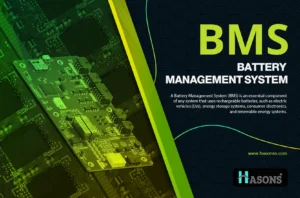Battery Management System
A lithium-ion battery pack is at the heart of every electric vehicle (EV). While advances in battery technology have enabled longer ranges and faster charging, battery management systems (BMS) are just as critical. A good BMS is the brains behind the high-voltage battery, ensuring safety, reliability and longevity over thousands of charge/discharge cycles.
What Does a Battery Management System Do?
A BMS performs several key functions:
Monitoring: The BMS continuously monitors current, voltage, temperature and state of charge of every cell in the battery pack. It detects anomalies and prevents damage.
Balancing: It balances the state of charge of individual cells by shunting current around cells that charge/discharge faster. This avoids overcharging or deep discharging of cells.
Protection: It has overcurrent, short circuit and over temperature protection. The BMS isolates faulty battery modules and prevents thermal runaway.
Communication: The BMS talks to the vehicle’s main computer using CAN bus and reports on battery status, range available etc. It also stores diagnostic data.
Charging: It controls the maximum rate of charge to avoid plating of lithium and other damage. The BMS optimizes charging based on temperature, cell voltages and more.
Heating/Cooling: BMS controls battery temperature for optimum performance. It regulates the battery thermal management system.
Without an advanced BMS with tight integration to the battery pack, EVs would simply not be practical or safe!
Key Components of a Battery Management System
Though BMS designs differ between automakers, these are some typical components:

Microcontroller Unit: The MCU or microprocessor is the brain running advanced algorithms for charging, cell monitoring and balancing.
Sensors: Voltage, current and temperature sensors provide data to the MCU. Some BMS place sensors at module, stack and pack level.
Cell Balancers: Balancers regulate charge flow between cells and avoid under or overcharging. Passive and active balancing methods are used.
Charge/Discharge Control FETs: These transistors or switches control the overall current flow in/out of pack. Useful for current limiting or emergency shutdown.
Communication Interfaces: CAN bus, LIN and ISO interfaces allow reporting to vehicle’s main computer and debugging by technicians.
Memory: Data logging memory stores cell voltages, temperatures and charge history. It helps diagnostics and warranty resolution.
Isolation Circuitry: This protects the BMS and isolates faulty battery modules. It ensures electrical faults don’t cascade.
Power Supply: Provides a stable DC supply voltage to BMS from the traction battery.
How Battery Manufacturers Ensure Safety Through Better BMS
Since a traction battery pack stores large amounts of high voltage energy, safety is paramount. Battery OEMs focus on safety at the cell, module and pack level:
Cell Safety: Internal protection within the cell prevents overcharge, over discharge and over temperature. Mandatory safety vents release pressure.
Module Safety: Cells are bundled into modules. Here again temperature, current and voltage limits avoid cell damage. Faulty modules can be isolated.
Pack Safety: At the pack level, further redundancy ensures safety even if individual cells or modules fail. Current, voltage and temperature limits act as final protection.
Software Safety: Well tested control algorithms are critical for safety. They are designed to be fail-safe and handle unexpected edge cases. Broadcast updates can enhance safety.
Hardware Safety: Physical hardwired safety mechanisms act as backup if software crashes or hardware like sensors fail. Examples – mechanical relays, thermal fuses.
Manufacturing Safety: Consistent quality control and manufacturing processes ensure reliable connections, waterproofing and minimum defects during battery assembly.
Through these layered safety mechanisms in batteries and the BMS, manufacturers minimize risks even in the unlikely event of catastrophic failures.
How Does A Battery Management System Monitor and Diagnose Issues?
The battery management system depends on data from sensors and advanced diagnostics to keep the battery pack healthy:
Voltage Metering: Cell voltage data is continuously collected by the BMS at a module and individual cell level. Sudden drops or imbalance sets off alarms.
Current Sensing: Current sensors at negative terminal detect discharge or regen current. Charge current is also monitored to prevent overload.
Temperature Sensing: Monitoring battery temperature down to the cell level allows early detection of hotspots and runaway conditions.
Impedance Testing: BMS estimates internal resistance by sending test pulses. Increased impedance signifies cell deterioration or connection issues.
State of Charge: Advanced estimation algorithms take current integration, voltage profiles and temperature data to calculate state of charge.
Data Logging: Extensive data logging during operation, charging and storage helps technicians diagnose root cause of faults – e.g. bad modules, charge defects etc.
These metrics offer deep insights into battery health and early warning signs of issues. The connected vehicle can also transmit data for preventative repair.
Wired vs Wireless Battery Management – The Trend Towards Modularity
In older EVs, the BMS had wired connectivity to individual cells or modules. But with larger battery packs, wireless approaches reduce cost, weight and assembly complexity.
Wired BMS: The BMS has physical wired connections to monitor or balance each cell group. This offers robust data but gets complex to assemble with 1000s of wires.
Module-level BMS: Separate BMS boards per module communicate digitally over CAN bus to a central controller. This reduces wiring without loss of cell monitoring.
Wireless BMS: Instead of physical links, wireless monitoring nodes per module use IoT protocols like Bluetooth to communicate with the pack controller. Further cost reduction.
Cell Monitoring ICs: Some advanced BMS integrate the monitoring chip with each cell, then aggregate data digitally up to the controller. This minimizes wires with continuous cell data.
The trend is towards more decentralized, wireless and modular BMS. Alongside, automated manufacturing using robotics is being adopted. This allows assembling large battery packs faster while retaining tight monitoring and process control.
Future Innovations to Improve Battery Management
While current BMS capabilities have enabled long range, low maintenance EVs, further innovations in battery management are coming:

Model Based Estimation: Physics based models and digital twins will allow estimation of internal battery states not directly measurable through sensors. This increases reliability.
AI Enhanced Diagnostics: As more battery performance data becomes available, AI approaches will identify parameters affecting life, accuracy of state of charge and predict faults better.
Edge Computing: Pushing computing down to the battery controller level instead of the main vehicle computer improves responsiveness and avoids latency in critical controls.
Encrypted Communications: To address growing cybersecurity concerns, hardware level authentication and encryption will be added to modules and communication buses like CAN.
Charging Optimization: Connection to cloud databases on cell chemistry behavior during fast charging will optimize charge rate based on real-time conditions to slow aging.
Modular Upgrades: New standardized mechanical and digital interfaces will allow updating battery modules, sensors and computing hardware through the vehicle lifetime.
Stronger Processor Hardware: Chip vendors are introducing processors that operate at up to 800V voltage seen in newer battery packs. This allows direct interfacing without step-down circuits.
With rising EV adoption, battery management innovation will accelerate driven by demand for longer lasting, safer and more reliable batteries. Leading BMS and battery vendors will continue pushing the edge through both software and hardware improvements.
Why Battery Management is Critical for Performance and Lifetime
While buyers focus on range, the battery management system enables power, safety and battery life:
Faster Charging: By carefully controlling charge current and cell voltages, the BMS enables faster DC charging without plating or lithium deposits degrading battery life.
Longevity: The BMS protects cells from extremes of temperature, voltage spikes or deep discharge – all factors that accelerate ageing. This extends battery lifespan with minimal maintenance for most owners.
Thermal Performance: During quick acceleration or fast charging, the BMS ensures even thermal distribution preventing hotspots. This allows the battery to repeatedly charge and discharge at high rates.
Energy Density: By preventing individual cell failures, the BMS safely allows pushing the cell technology innovations happening on the cutting edge for higher density.
Resale Value: Batteries account for 1/3rd of an EV cost. Well preserved batteries through effective thermal and electrical management lead to higher resale value after years of use.
A battery may seem like a black box under the vehicle floor. But the intelligent battery management system keeps your EV running safely for the long haul. As automakers plan million mile batteries, advanced BMS will be key enablers.
Conclusion
The battery management system is crucial for battery pack safety, performance monitoring, accurate range estimation and long lifetime in electric vehicles. As automakers rapidly increase EV investments to go all electric this decade, battery management innovation must keep pace through a cross-functional approach spanning cell science, power electronics, communications and big data analytics. A holistic view across these domains will deliver the quality EV experience customers demand. Combined hardware and algorithm improvements on both the vehicle side and grid side are taking EVs towards the next frontier.
| For updates in the Battery Management System, read Hasons Blogs. Some of them are as follows: | ||
| Spatial Computing | Application of Computer Graphics | |
| Laser Printer | Operating System Structure | |
Battery Management System
